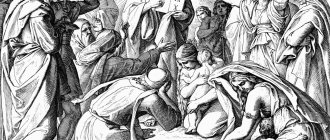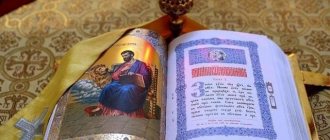Fragment of El Greco’s painting “The Apostles Peter and Paul”
The Apostle Paul, addressing Christians, says: “...I praise you, brethren, because you remember everything I have and keep the tradition as I handed it down to you” (1 Cor. 11:2). But Martin Luther's epistles from St. He did not include Paul in the realm of “Tradition,” but considered him part of “Scripture.” Modern Protestants think like him. So what is this “Tradition”?
What is Sacred Tradition in Christianity
of the 2nd defined it . Tertullian:
“We preserve the rule of faith that the Church received from the apostles, the apostles from Christ, Christ from God.”
And the Apostle Paul writes to his spiritual children from Thessalonica: “...stand and hold to the traditions which you were taught either by our word or by our epistle” (2 Thess. 2:15).
Thus, Christians of the first centuries did not distinguish between the “rules of faith” that were recorded in written texts and those that were transmitted orally.
El Greco Apostles Peter and Paul. Around 1587-1592 Oil on canvas. 121.5 × 105 cm State Hermitage Museum, St. Petersburg
How is faith transmitted?
It is well known: she is a gift from God. It cannot be “convinced”; it should not be told to those who have not experienced the touch of Grace. This gift of the Spirit from the day of Pentecost to the present day is transmitted, as is known, through the laying on of hands, prayer - the Apostles, their disciples, and the bishops . Consecration by grace has been the basis of the life of the Church to this day. It is characteristic that Protestants, proceeding from the principle of “Scripture only,” now do not have the priesthood, do not venerate the saints - that is, they have abandoned the gifts given to the Apostles by God Himself.
If we talk about the verbal preaching of faith, historically the first way to convey its truths was the spoken word - of Christ, then of His disciples, and after many years - of their spiritual children.
Are the writings of Christ known?
There are no written works left from the Founder of Christianity Himself; His sermon was a living word, not written texts, and was written down at least several decades later. Most of the Gospels appeared in the 60s. I century, most recently – St. John the Theologian - even at the turn of the 1st and 2nd centuries. True, there is a story about a letter from Christ to Abgar, the ruler of the city of Edessa (now Urfa).
King Abgar of Edessa sends a letter to Christ. Miniature from the Alaverdi Gospel. 1054 (L. 316 vol.)
Having fallen ill with leprosy, he sent a painter to Christ to depict His Face. The same man apparently delivered a letter to the Preacher from Galilee: Abgar, saying that he knew the intention of the Jews to kill the Savior, invited Him to settle in Edessa.
The answer to this message, as they say, was a letter from the Lord, perhaps the only known text written by Him with His own hand. Christ did not want to shy away from the coming suffering, and the ruler promised complete healing from the hand of His disciple, who would come to him in due time.
For at least several decades, the letter was kept above the gates of Edessa along with the Image of the Savior Not Made by Hands (the artist was never able to paint It, so Christ Himself wiped it with a cloth on which the image was miraculously imprinted). But both relics have not survived to this day. But the words of the Lord, once worn out on the streets of the cities of Judea, came through thanks to the writings of His disciples.
This is interesting:
The secret of the relic: where is the world's first icon - the Savior Not Made by Hands
How was Scripture created?
For more than 20 years, the preaching of the Apostles was also oral. It was only with the spread of Christianity beyond the borders of Judea, when there were already many Christians throughout the Roman Empire, that written messages were naturally required. It is clear that, since of all the Apostles, St. worked the most in preaching among the pagans. Pavel, the first of them belong to him. According to church historians, the oldest of them may be the Epistle of St. Paul to the Galatians, written around 48 - about 10 years earlier than the Gospels.
After some time, Christians also felt the need for a written presentation of the truths conveyed orally by the Savior. This is how the Gospels appeared. S.S. Averintsev draws attention to the fact that in the original this is a rhymed text (unfortunately, the rhyme was lost in translations). The scientist wrote:
“When semitologists began experiments to reconstruct the primordial Aramaic form of the Gospel sayings, the results exceeded all expectations: under the slow rhythm of the Greek text of the Gospels, compressed, elastic speech emerged, more similar to energetic verses than to prose,... falling naturally into the memory, like folk saying."
This means that the Gospels were first an oral and not a written text - that is, the oral word itself, it turns out, is older than Scripture.
Sacred Tradition, Sacred Scripture and the Bible - what is the difference
So, the spoken word - as the transmission of faith - precedes the transmission of its truths in writing. Moreover, based on Tertullian’s words that it goes back to Christ Himself, we can say that the spoken word is generally the first form of transmission of Christian truths, for a long time - even the main, if not the only one. Subsequently, letters appear, then books - first the Epistles of the Apostles, then the Gospels, and finally - in a similar way, through the scriptures, along with the spoken word, subsequent holy fathers convey the faith.
Therefore, we can say that Tradition is actually the totality of the truths of faith, transmitted to subsequent generations of Christians or other peoples who previously did not know the True God (as was the case with the Greeks, Bulgarians, Scythians, Slavs). Well, Scripture, including the Bible (Christians call the books of the Old and New Testaments together) is one of the ways of transmitting faith, written.
Already by the 60s. ap. Luke (Luke 1:1) states: there are a lot of such works; “many” write sermons about Christ, His earthly life. And over the following centuries, the question of separating truth from lies in these writings (and oral stories) has become quite acute for the Church.
What is the Bible, Holy Scripture and Holy Tradition. Scheme
What sources contain Sacred Tradition?
The forms of preservation of Sacred Tradition are: Holy Scripture, definitions of Ecumenical and a number of Local Councils, liturgical texts (prayer, rites of worship, hymnography, etc.), works of the holy fathers and teachers of the Church accepted by the Church, lives of saints, iconography, etc. However, not everything contained in these sources is Tradition itself. Thus, a work on church history or the lives of saints may contain, along with the evidence of Tradition, information that is not directly related to the Christian faith.
Attitude to Sacred Tradition in different confessions
Until the beginning of the Reformation ( October 31, 1517 ), both Catholics and Orthodox Christians adhered to the traditional position of early Christianity, not distinguishing whether the faith was transmitted orally or in writing.
Interesting fact
The starting point for the changes was the famous dispute between Martin Luther and Vatican theologians, when he questioned the primacy of the Pope as the head of the Christian world. When theologians said they needed time to find the materials of the Councils that established this tradition, Luther declared that he could resolve the question based on Scripture alone, where there is not a word about the primacy of the Roman Pontiff.
It is believed that this is how, in polemics, the Protestant teaching appeared that Scripture is more important than its “human interpretations,” thus, from the great Tradition that came down through the centuries, one part was isolated - written texts.
It is clear that this was completely inconsistent with the general church understanding.
However, in discussions between Catholics and supporters of the Reformation, a conviction gradually developed that is now characteristic of Western Christians: Scripture and Tradition are two different sources of faith, most often unequal:
- Catholics began to recognize the highest authority for Scripture, and for other elements of the experience of the Church - a certain auxiliary function of explaining Scripture;
- Protestants developed the principle of “Scripture only,” essentially rejecting the entire experience of the Church, which is not recorded in writing; Of course, the fact that, for example, the spoken word originally precedes Scripture remains unknown to many modern Protestants; the prevailing position is that the “original” (?) meanings of written texts were allegedly distorted by people.
Martin Luther at the Worms Reichstag
What is considered Holy Tradition in the Orthodox Church
Western ideas about the separation of Scripture and Tradition from the 17th-18th centuries. also penetrated into Orthodox theology:
- for example, Met. Macarius (Bulgakov) attributed to the realm of tradition “the Word of God, not contained in writing by the inspired writers themselves, but orally transmitted to the Church and since then continuously preserved in it”;
- the point of view about Scripture and Tradition as two sources of faith can also be found in many textbooks of dogmatic theology of the 19th-20th centuries.
Among modern Orthodox theologians one can find an understanding of Tradition:
- as truths of faith not recorded in writing, but accepted by the Church;
- as the Apostolic Sermon, the experience of the Apostles, which was transmitted to the Church;
- as in general the experience of the Church from its beginning to the present day.
Thus, there are both understandings traditional for early Christianity and positions that arose under Western Christian influence.
But, as a rule, the area of Tradition includes:
- Scripture, as one of its forms - written;
- The Creed as now accepted, as well as the earlier confessions of faith of the first centuries;
- ancient church rules, canons dating back to the Apostles;
- rules, definitions of Councils - Ecumenical, as well as some Local Councils, which were accepted by the fullness of the Church;
- the liturgical practice of the Church, including not only texts, liturgical actions, but also iconography, features of the structure of the temple, and the general organization of the space of worship;
- lives of saints, as well as church historical works dating back to antiquity;
- creations of the holy fathers;
- ancient traditions, pious customs preserved by the Church since ancient times.
What does Sacred Tradition consist of?
What is “Apostolic Tradition”
This concept has two meanings:
- the actual experience of the Apostles, the truths of faith that they received from Christ, were passed on to their disciples;
- an ancient written monument describing the structure of Christian communities of the first centuries; its original has not survived to this day, but individual passages are presumably the authorship of Sschmch. Hippolytus, Pope (235), are found in later works; the source describes the structure of communities and worship.
Russian Orthodox Church
On December 19, 2014, at the Veliko Tarnovo University named after Saints Cyril and Methodius (Bulgaria), a solemn ceremony was held to present the honorary degree of doctor honoris causa of this university to the chairman of the Department for External Church Relations of the Moscow Patriarchate, chairman of the Synodal Biblical-Theological Commission, Metropolitan Hilarion of Volokolamsk. Vladyka Hilarion gave an official speech.
1. Scripture and Tradition
Christianity is a revealed religion. In the Orthodox understanding, Divine Revelation includes Holy Scripture and Holy Tradition. Scripture is the entire Bible, that is, all the books of the Old and New Testaments. As for Tradition, this term requires special clarification, since it is used in different meanings. Tradition is often understood as the entire set of written and oral sources with the help of which the Christian faith is passed on from generation to generation. The Apostle Paul says: “Stand fast and hold to the traditions which you were taught either by our word or by our epistle” (2 Thess. 2:15). By “word” here we mean oral Tradition, by “message” - written. Saint Basil the Great included the sign of the cross, turning in prayer to the east, the epiclesis of the Eucharist, the rite of consecration of the water of baptism and the oil of anointing, the threefold immersion of a person at baptism, etc., to the oral Tradition, that is, predominantly liturgical or ritual traditions transmitted orally and firmly entered into church practice. Subsequently, these customs were recorded in writing - in the works of the Fathers of the Church, in the decrees of the Ecumenical and Local Councils, in liturgical texts. A significant part of what was originally oral Tradition became written Tradition, which continued to coexist with oral Tradition.
If Tradition is understood in the sense of the totality of oral and written sources, then how does it relate to Scripture? Is Scripture something external to Tradition, or is it an integral part of Tradition?
Before answering this question, it should be noted that the problem of the relationship between Scripture and Tradition, although reflected in many Orthodox authors, is not Orthodox in origin. The question of what is more important, Scripture or Tradition, was raised during the controversy between the Reformation and Counter-Reformation in the 16th-17th centuries. The leaders of the Reformation (Luther, Calvin) put forward the principle of “the sufficiency of Scripture,” according to which only Scripture enjoys absolute authority in the Church; As for later doctrinal documents, be they decrees of Councils or the works of the Fathers of the Church, they are authoritative only insofar as they are consistent with the teaching of Scripture. Those dogmatic definitions, liturgical and ritual traditions that were not based on the authority of Scripture could not, according to the leaders of the Reformation, be recognized as legitimate and therefore were subject to abolition. With the Reformation, the process of revision of Church Tradition began, which continues in the depths of Protestantism to this day.
In contrast to the Protestant principle of “sola Scriptura” (Latin for “Scripture alone”), Counter-Reformation theologians emphasized the importance of Tradition, without which, in their opinion, Scripture would have no authority. Luther's opponent at the Leipzig Disputation of 1519 argued that "Scripture is not authentic without the authority of the Church." Opponents of the Reformation pointed out, in particular, that the canon of Holy Scripture was formed precisely by Church Tradition, which determined which books should be included in it and which should not. At the Council of Trent in 1546, the theory of two sources was formulated, according to which Scripture cannot be considered as the only source of Divine Revelation: an equally important source is Tradition, which constitutes a vital addition to Scripture.
Russian Orthodox theologians of the 19th century, speaking about Scripture and Tradition, placed emphasis somewhat differently. They insisted on the primacy of Tradition in relation to Scripture and traced the beginning of Christian Tradition not only to the New Testament Church, but also to the times of the Old Testament. Saint Philaret of Moscow emphasized that the Holy Scripture of the Old Testament began with Moses, but before Moses, the true faith was preserved and spread through Tradition. As for the Holy Scripture of the New Testament, it began with the Evangelist Matthew, but before that “the foundation of dogmas, the teaching of life, the rules of worship, the laws of church government” were in Tradition.
At A.S. Khomyakov, the relationship between Tradition and Scripture is considered in the context of the teaching about the action of the Holy Spirit in the Church. Khomyakov believed that Scripture is preceded by Tradition, and Tradition is preceded by “deed,” by which he understood revealed religion, starting from Adam, Noah, Abraham and other “ancestors and representatives of the Old Testament Church.” The Church of Christ is a continuation of the Old Testament Church: the Spirit of God lived and continues to live in both. This Spirit acts in the Church in a variety of ways - in Scripture, Tradition and in practice. The unity of Scripture and Tradition is comprehended by a person who lives in the Church; Outside the Church it is impossible to comprehend either Scripture, Tradition, or deeds.
In the 20th century, Khomyakov’s thoughts about Tradition were developed by V.N. Lossky. He defined Tradition as “the life of the Holy Spirit in the Church, the life that imparts to each member of the Body of Christ the ability to hear, accept, and know the Truth in its inherent light, and not in the natural light of the human mind.” According to Lossky, life in Tradition is a condition for the correct perception of Scripture, it is nothing more than knowledge of God, communication with God and vision of God, which were inherent in Adam before his expulsion from paradise, the biblical forefathers Abraham, Isaac and Jacob, the seer Moses and the prophets, and then “ eyewitnesses and ministers of the Word" (Luke 1:2) - the apostles and followers of Christ. The unity and continuity of this experience, preserved in the Church right up to the present time, constitutes the essence of Church Tradition. A person outside the Church, even if he studied all the sources of Christian doctrine, will not be able to see its inner core.
Answering the question posed earlier about whether Scripture is something external to Tradition or an integral part of the latter, we must say with all certainty that in the Orthodox understanding Scripture is part of Tradition and is unthinkable outside of Tradition. Therefore, Scripture is by no means self-sufficient and cannot by itself, isolated from church tradition, serve as a criterion of Truth. The books of Holy Scripture were created at different times by different authors, and each of these books reflected the experience of a particular person or group of people, reflecting a certain historical stage in the life of the Church, including the Old Testament period). The primary was experience, and the secondary was its expression in the books of Scripture. It is the Church that gives these books - both the Old and the New Testaments - the unity that they lack when viewed from a purely historical or textual point of view.
The Church considers Scripture to be “inspired by God” (2 Tim. 3:16), not because the books included in it were written by God, but because the Spirit of God inspired their authors, revealed the Truth to them, and held together their scattered writings into a single whole. But in the action of the Holy Spirit there is no violence over the mind, heart and will of man; on the contrary, the Holy Spirit helped man to mobilize his own inner resources to comprehend the key truths of the Christian Revelation. The creative process, the result of which was the creation of a particular book of Holy Scripture, can be represented as a synergy, joint action, collaboration between man and God: a person describes certain events or sets out various aspects of a teaching, and God helps him to understand and adequately express them. The books of Holy Scripture were written by people who were not in a state of trance, but in sober memory, and each of the books bears the imprint of the creative individuality of the author.
Fidelity to Tradition and life in the Holy Spirit helped the Church to recognize the internal unity of the Old Testament and New Testament books, created by different authors at different times, and from all the diversity of ancient written monuments to select into the canon of Holy Scripture those books that are bound by this unity, to separate divinely inspired works from non-inspired ones. inspired.
2. Holy Scripture in the Orthodox Church
In the Orthodox tradition, the Old Testament, the Gospel and the corpus of the Apostolic Epistles are perceived as three parts of an indivisible whole. At the same time, the Gospel is given unconditional preference as a source that brings the living voice of Jesus to Christians, the Old Testament is perceived as prefiguring Christian truths, and the Apostolic Epistles are perceived as an authoritative interpretation of the Gospel belonging to Christ’s closest disciples. In accordance with this understanding, the Hieromartyr Ignatius the God-Bearer in his letter to the Philadelphians says: “Let us resort to the Gospel as to the flesh of Jesus, and to the apostles as to the presbytery of the Church. Let us also love the prophets, for they also proclaimed what pertains to the Gospel, they trusted in Christ and looked for Him and were saved by faith in Him.”
The doctrine of the Gospel as “the flesh of Jesus,” His incarnation in the word, was developed by Origen. Throughout Scripture he sees the “kenosis” (exhaustion) of God the Word incarnating himself in the imperfect forms of human words: “Everything that is recognized as the word of God is the revelation of the Word of God made flesh, which was with God in the beginning (John 1:2) and exhausted Himself.” . Therefore, we recognize the Word of God made man as something human, for the Word in the Scriptures always becomes flesh and dwells among us (John 1:14).”
This explains the fact that in Orthodox worship the Gospel is not only a book to read, but also an object of liturgical worship: the closed Gospel lies on the throne, it is kissed, it is taken out for worship by the faithful. During the episcopal consecration, the revealed Gospel is placed on the head of the person being ordained, and during the sacrament of the Blessing of Unction, the revealed Gospel is placed on the head of the sick person. As an object of liturgical worship, the Gospel is perceived as a symbol of Christ Himself.
In the Orthodox Church, the Gospel is read daily during worship. For liturgical reading, it is divided not into chapters, but into “conceptions.” The four Gospels are read in their entirety in the Church throughout the year, and for each day of the church year there is a specific Gospel beginning, which the believers listen to while standing. On Good Friday, when the Church remembers the suffering and death of the Savior on the cross, a special service is held with the reading of twelve Gospel passages about the passion of Christ. The annual cycle of Gospel readings begins on the night of Holy Easter, when the prologue of the Gospel of John is read. After the Gospel of John, which is read during the Easter period, the readings of the Gospels of Matthew, Mark and Luke begin.
The Acts of the Apostles, conciliar epistles and the epistles of the Apostle Paul are also read in the Church every day and are also read in their entirety throughout the year. The reading of the Acts begins on the night of Holy Easter and continues throughout the Easter period, followed by the conciliar epistles and the epistles of the Apostle Paul.
As for the books of the Old Testament, they are read selectively in the Church. The basis of Orthodox worship is the Psalter, which is read in its entirety throughout the week, and twice a week during Lent. During Lent, conceptions from the Books of Genesis and Exodus, the Book of the Prophet Isaiah, and the Book of the Wisdom of Solomon are read daily. On holidays and days of remembrance of especially revered saints, it is necessary to read three “proverbs” - three passages from the books of the Old Testament. On the eve of the great holidays - on the eve of Christmas, Epiphany and Easter - special services are held with the reading of a larger number of proverbs (up to fifteen), representing a thematic selection from the entire Old Testament relating to the celebrated event.
In the Christian tradition, the Old Testament is perceived as a prototype of New Testament realities and is viewed through the prism of the New Testament. This kind of interpretation is called “typological” in science. It began with Christ Himself, who said about the Old Testament: “Search the Scriptures, for through them you think you have eternal life; and they testify of Me” (John 5:39). In accordance with this instruction of Christ, in the Gospels many events from His life are interpreted as the fulfillment of Old Testament prophecies. Typological interpretations of the Old Testament are found in the epistles of the Apostle Paul, especially in the Epistle to the Hebrews, where the entire Old Testament history is interpreted in a representative, typological sense. The same tradition is continued in the liturgical texts of the Orthodox Church, filled with allusions to events from the Old Testament, which are interpreted in relation to Christ and the events from His life, as well as to events from the life of the New Testament Church.
According to the teachings of Gregory the Theologian, the Holy Scriptures contain all the dogmatic truths of the Christian Church: you just need to be able to recognize them. Nazianzen proposes a method of reading Scripture that can be called “retrospective”: it consists in considering the texts of Scripture based on the subsequent Tradition of the Church, and identifying in them those dogmas that were more fully formulated in a later era. This approach to Scripture is fundamental in the patristic period. In particular, according to Gregory, not only the New Testament, but also the Old Testament texts contain the doctrine of the Holy Trinity.
Thus, the Bible must be read in the light of the dogmatic tradition of the Church. In the 4th century, both Orthodox and Arians resorted to the texts of Scripture to confirm their theological positions. Depending on these settings, different criteria were applied to the same texts and interpreted differently. For Gregory the Theologian, as for other Church Fathers, in particular Irenaeus of Lyons, there is one criterion for the correct approach to Scripture: fidelity to the Tradition of the Church. Only that interpretation of biblical texts is legitimate, Gregory believes, which is based on Church Tradition: any other interpretation is false, since it “robs” the Divine. Outside the context of Tradition, biblical texts lose their dogmatic significance. And vice versa, within Tradition, even those texts that do not directly express dogmatic truths receive new understanding. Christians see in the texts of Scripture what non-Christians do not see; to the Orthodox is revealed what remains hidden from heretics. The mystery of the Trinity for those outside the Church remains under a veil, which is removed only by Christ and only for those who are inside the Church.
If the Old Testament is a prototype of the New Testament, then the New Testament, according to some interpreters, is the shadow of the coming Kingdom of God: “The Law is the shadow of the Gospel, and the Gospel is the image of future blessings,” says Maximus the Confessor. The Monk Maximus borrowed this idea from Origen, as well as the allegorical method of interpreting Scripture, which he widely used. The allegorical method made it possible for Origen and other representatives of the Alexandrian school to consider stories from the Old and New Testaments as prototypes of the spiritual experience of an individual human personality. One of the classic examples of a mystical interpretation of this kind is Origen’s interpretation of the Song of Songs, where the reader goes far beyond the literal meaning and is transported to another reality, and the text itself is perceived only as an image, a symbol of this reality.
After Origen, this type of interpretation became widespread in the Orthodox tradition: we find it, in particular, in Gregory of Nyssa, Macarius of Egypt and Maximus the Confessor. Maximus the Confessor spoke of the interpretation of Holy Scripture as an ascent from the letter to the spirit. The anagogical method of interpreting Scripture (from the Greek anagogê, ascent), like the allegorical method, proceeds from the fact that the mystery of the biblical text is inexhaustible: only the outer outline of Scripture is limited by the framework of the narrative, and “contemplation” (theôria), or the mysterious inner meaning, is limitless. Everything in Scripture is connected with the inner spiritual life of man, and the letter of Scripture leads to this spiritual meaning.
Typological, allegorical and anagogical interpretation of Scripture also fills the liturgical texts of the Orthodox Church. For example, the Great Canon of St. Andrew of Crete, read during Lent, contains a whole gallery of biblical characters from the Old and New Testaments; in each case, the example of a biblical hero is accompanied by a commentary with reference to the spiritual experience of the person praying or a call to repentance. In this interpretation, the biblical character becomes a prototype of every believer.
If we talk about the Orthodox monastic tradition of interpreting the Holy Scriptures, then first of all it should be noted that the monks had a special attitude towards the Holy Scriptures as a source of religious inspiration: they not only read and interpreted it, but also memorized it. Monks, as a rule, were not interested in the “scientific” exegesis of Scripture: they viewed Scripture as a guide to practical activity and sought to understand it through the implementation of what was written in it. In their writings, the ascetic Holy Fathers insist that everything said in Scripture must be applied to one’s own life: then the hidden meaning of Scripture will become clear.
In the ascetic tradition of the Eastern Church there is the idea that reading the Holy Scriptures is only an auxiliary means on the path of the spiritual life of the ascetic. The statement of the Monk Isaac the Syrian is characteristic: “Until a person accepts the Comforter, he needs the Divine Scriptures... But when the power of the Spirit descends into the spiritual power operating in a person, then instead of the law of the Scriptures, the commandments of the Spirit take root in the heart...” According to the thought of St. Simeon the New Theologian, the need for Scripture disappears when a person meets God face to face.
The above judgments of the Fathers of the Eastern Church by no means deny the need to read the Holy Scriptures and do not diminish the significance of Scripture. Rather, it expresses the traditional Eastern Christian view that the experience of Christ in the Holy Spirit is superior to any verbal expression of this experience, whether in the Holy Scriptures or any other authoritative written source. Christianity is a religion of encountering God, not of bookish knowledge of God, and Christians are by no means “people of the Book,” as they are called in the Koran. Hieromartyr Hilarion (Troitsky) considers it no coincidence that Jesus Christ did not write a single book: the essence of Christianity is not in moral commandments, not in theological teaching, but in the salvation of man by the grace of the Holy Spirit in the Church founded by Christ.
Insisting on the priority of church experience, Orthodoxy rejects those interpretations of Holy Scripture that are not based on the experience of the Church, contradict this experience, or are the fruit of the activity of an autonomous human mind. This is the fundamental difference between Orthodoxy and Protestantism. By proclaiming the principle of “sola Scriptura” and rejecting the Tradition of the Church, Protestants opened up wide scope for arbitrary interpretations of the Holy Scriptures. Orthodoxy claims that outside the Church, outside Tradition, a correct understanding of Scripture is impossible.
3. Composition and authority of Tradition. Patristic heritage
In addition to the Holy Scriptures of the Old and New Testaments, the Tradition of the Orthodox Church includes other written sources, including liturgical texts, orders of the sacraments, decrees of the Ecumenical and Local Councils, the works of the Fathers and teachers of the ancient Church. What is the authority of these texts for an Orthodox Christian?
The doctrinal definitions of the Ecumenical Councils, which have undergone church reception, enjoy unconditional and indisputable authority. First of all, we are talking about the Nicene-Constantinopolitan Creed, which is a summary statement of Orthodox doctrine adopted at the First Ecumenical Council (325) and supplemented at the Second Council (381). We are also talking about other dogmatic definitions of the Councils included in the canonical collections of the Orthodox Church. These definitions are not subject to change and are generally binding for all members of the Church. As for the disciplinary rules of the Orthodox Church, their application is determined by the real life of the Church at each historical stage of its development. Some rules established by the Fathers of antiquity are preserved in the Orthodox Church, while others have fallen into disuse. The new codification of canon law is one of the urgent tasks of the Orthodox Church.
The liturgical Tradition of the Church enjoys unconditional authority. In their dogmatic impeccability, the liturgical texts of the Orthodox Church follow the Holy Scriptures and the creeds of the Councils. These texts are not just the creations of eminent theologians and poets, but part of the liturgical experience of many generations of Christians. The authority of liturgical texts in the Orthodox Church is based on the reception to which these texts were subjected for many centuries, when they were read and sung everywhere in Orthodox churches. Over these centuries, everything erroneous and alien that could have crept into them through misunderstanding or oversight was weeded out by Church Tradition itself; all that remained was pure and impeccable theology, clothed in the poetic forms of church hymns. That is why the Church recognized liturgical texts as the “rule of faith”, as an infallible doctrinal source.
The next most important place in the hierarchy of authorities is occupied by the works of the Church Fathers. Among the patristic heritage, the works of the Fathers of the Ancient Church, especially the Eastern Fathers, who had a decisive influence on the formation of Orthodox dogma, have priority importance for an Orthodox Christian. The opinions of the Western Fathers, consistent with the teachings of the Eastern Church, are organically woven into the Orthodox Tradition, which contains both Eastern and Western theological heritage. The same opinions of Western authors, which are in clear contradiction with the teachings of the Eastern Church, are not authoritative for an Orthodox Christian.
In the works of the Fathers of the Church, it is necessary to distinguish between the temporary and the eternal: on the one hand, that which retains value for centuries and has an immutable significance for the modern Christian, and on the other, that which is the property of history, that was born and died within the context in which This church author lived. For example, many natural scientific views contained in the “Conversations on the Six Days” of Basil the Great and in the “Accurate Exposition of the Orthodox Faith” by John of Damascus are outdated, while the theological understanding of the created cosmos by these authors retains its significance in our time. Another similar example is the anthropological views of the Byzantine Fathers, who believed, like everyone else in the Byzantine era, that the human body consists of four elements, that the soul is divided into three parts (reasonable, desirable and irritable). These views, borrowed from ancient anthropology, are now outdated, but much of what the mentioned Fathers said about man, about his soul and body, about passions, about the abilities of the mind and soul has not lost its meaning in our days.
In the patristic writings, in addition, it is necessary to distinguish what was said by their authors on behalf of the Church and what expresses the general Church teaching, from private theological opinions (theologumen). Private opinions should not be cut off to create some simplified “sum of theology”, to derive some “common denominator” of Orthodox dogmatic teaching. At the same time, a private opinion, even if its authority is based on the name of a person recognized by the Church as a Father and teacher, since it is not sanctified by the conciliar reception of church reason, cannot be placed on the same level with opinions that have passed such a reception. A private opinion, as long as it was expressed by the Father of the Church and was not condemned by the council, is within the boundaries of what is permissible and possible, but cannot be considered generally binding for Orthodox believers.
In the next place after the patristic writings are the works of the so-called teachers of the Church - theologians of antiquity who influenced the formation of church teaching, but for one reason or another were not elevated by the Church to the rank of Fathers (these include, for example, Clement of Alexandria and Tertullian). Their opinions are authoritative insofar as they are consistent with general Church teaching.
Of the apocryphal literature, only those monuments that are prescribed in worship or in hagiographic literature can be considered authoritative. The same apocrypha that were rejected by the church consciousness have no authority for the Orthodox believer.
Worthy of special mention are the works on dogmatic topics that appeared in the 16th-19th centuries and are sometimes called the “symbolic books” of the Orthodox Church, written either against Catholicism or against Protestantism. Such documents include, in particular: the responses of the Patriarch of Constantinople Jeremiah II to Lutheran theologians (1573-1581); Confession of Faith of Metropolitan Macarius Kritopoulos (1625); Orthodox Confession of Metropolitan Peter Mohyla (1642); Confession of Faith of the Patriarch of Jerusalem Dositheos (1672), known in Russia under the name “Epistle of the Eastern Patriarchs”; a number of anti-Catholic and anti-Protestant messages of the Eastern Patriarchs of the 18th - first half of the 19th centuries; Letter of the Eastern Patriarchs to Pope Pius IX (1848); Reply of the Synod of Constantinople to Pope Leo IX (1895). According to Archbishop Vasily (Krivoshein), these works, compiled during a period of strong heterodox influence on Orthodox theology, have secondary authority.
Finally, it is necessary to say about the authority of the works of modern Orthodox theologians on doctrinal issues. The same criterion can be applied to these works as to the writings of the ancient teachers of the Church: they are authoritative to the extent that they correspond to Church Tradition and reflect the patristic way of thinking. Orthodox authors of the 20th century made a significant contribution to the interpretation of various aspects of the Orthodox Tradition, the development of Orthodox theology and its liberation from alien influences, and the clarification of the foundations of the Orthodox faith in the face of non-Orthodox Christians. Many works of modern Orthodox theologians have become an integral part of the Orthodox Tradition, adding to the treasury into which, according to Irenaeus of Lyons, the apostles put “everything that relates to the truth,” and which over the centuries has been enriched with more and more new works on theological topics.
Thus, Orthodox Tradition is not limited to any one era, which remains in the past, but is directed forward to eternity and is open to any challenges of time. According to Archpriest Georgy Florovsky, “The Church now has no less authority than in past centuries, for the Holy Spirit lives it no less than in former times”; therefore, one cannot limit the “age of the Fathers” to any time in the past. And the famous modern theologian Bishop Kallistos (Ware) of Diokleia says: “An Orthodox Christian must not only know and quote the Fathers, but be deeply imbued with the patristic spirit and adopt the patristic “way of thinking”... To assert that there can be no more Holy Fathers is to assert that the Holy Spirit has left the Church."
So, the “golden age” begun by Christ, the apostles and the ancient Fathers will continue as long as the Church of Christ stands on earth and as long as the Holy Spirit operates in it.
DECR Communications Service/ Patriarchia.ru
Sacred Tradition and “human traditions”
In a broad sense, “human” is the entire experience of the Church, as conveyed by people - the Apostles. The Lord Himself also was and remains a perfect Man. At the same time, He more than once tells the Pharisees that they “have made void the commandment of God by their tradition,” and they worship God in vain, “teaching doctrines the commandments of men” (Matthew 15:6,9). So, not everything known since ancient times is divinely inspired; much was brought in “from the mind” damaged by sin.
What is the criterion for the Church that this or that custom, text, or liturgical order belongs to the realm of Tradition? This:
- agreement with the teachings of Christ transmitted by the Apostles;
- agreement with the conciliar experience of the Church.
So, not all “human tradition,” even if pious, becomes Sacred, but only that which is accepted by the fullness of the Church has God’s blessing. It is not without reason that at the first Apostolic Council (about 42) the formula was first heard: “It has pleased the Holy Spirit and us.”
First Apostolic Assembly (Council)
On the meaning of the expressions “Apostolic Tradition” and “Holy Tradition”
These expressions can be viewed in theology in different ways. Thus, Apostolic Tradition may mean Tradition acquired by the Church directly from the Apostles. This is the narrow meaning of the expression in question. In this case, it is not identical to the expression “Holy Tradition”, understood broadly. On the other hand, given that Sacred Tradition in a broad sense corresponds to the apostolic teaching and the saving apostolic experience in spirit, it is also permissible to designate it as Apostolic (in this case, the expression “Apostolic Tradition” is given a broader meaning).
The relationship of Sacred Tradition to the Apocrypha
Both His adherents and opponents or false interpreters wrote about Christ. It took the Church about 400 years to define a "canon" of recognized sacred written texts. Much of what was written during the first centuries of Christianity was not included there . Such works are called “apocrypha” based on:
- of dubious origin or unclear authorship with content consistent with the spirit of the teachings of Christ;
- or - clearly heretical content.
The first type of apocrypha, although not related to Scripture itself, is recognized as preserving ancient Christian traditions, the memory of events.
The Proto-Gospel of James and the Gospel of Nicodemus are the most “popular” sources of Holy Tradition
The first of these monuments dates back, as established, to the 2nd century, the second to the 4th century.










